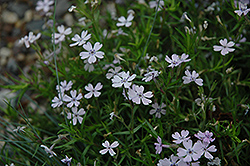It's all about ...
plants

Plant Height: 4 inches
Flower Height: 6 inches
Spacing: 15 inches
Sunlight:
![]()
![]()
Hardiness Zone: 3a
Other Names: Cleft Phlox
Description:
Vigorous mats of dark evergreen foliage that is covered with lavender star shaped flowers in spring; grows well in rocky ravine areas or well drained, sandy soils; great for beds, border fronts or edging; low to moderate water requirement
Ornamental Features
Sand Phlox is covered in stunning lavender star-shaped flowers at the ends of the stems from early to late spring. Its tiny narrow leaves remain green in colour throughout the year.
Landscape Attributes
Sand Phlox is an herbaceous evergreen perennial with a ground-hugging habit of growth. It brings an extremely fine and delicate texture to the garden composition and should be used to full effect.
This is a relatively low maintenance plant, and is best cleaned up in early spring before it resumes active growth for the season. It has no significant negative characteristics.
Sand Phlox is recommended for the following landscape applications;
- Mass Planting
- Rock/Alpine Gardens
- Border Edging
- General Garden Use
- Groundcover
Planting & Growing
Sand Phlox will grow to be only 4 inches tall at maturity extending to 6 inches tall with the flowers, with a spread of 18 inches. When grown in masses or used as a bedding plant, individual plants should be spaced approximately 15 inches apart. Its foliage tends to remain low and dense right to the ground. It grows at a medium rate, and under ideal conditions can be expected to live for approximately 10 years. As an evegreen perennial, this plant will typically keep its form and foliage year-round.
This plant does best in full sun to partial shade. It prefers dry to average moisture levels with very well-drained soil, and will often die in standing water. It is considered to be drought-tolerant, and thus makes an ideal choice for a low-water garden or xeriscape application. This plant should not require much in the way of fertilizing once established, although it may appreciate a shot of general-purpose fertilizer from time to time early in the growing season. It is not particular as to soil pH, but grows best in sandy soils. It is somewhat tolerant of urban pollution. This species is native to parts of North America. It can be propagated by division.
